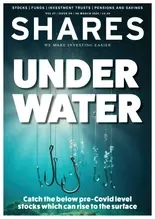
Shares in high street lender NatWest Group (NWG) outpaced those of its rivals, reversing early losses to trade up 1.7% at 174p after the bank posted what it called ‘resilient’ results for last year and promised future capital returns, starting with a resumption of dividends this year.
Despite recording a pre-tax loss of £753 million for the year to December as a result of lower consumer and business activity, the bank’s Core Equity Tier One (CET1) ratio climbed 230 basis points (2.3%) to 18.5%, well above that of its peers.
CAPITAL RETURNS
Chief executive Alison Rose highlighted the bank’s elevated capital ratio and said the group aimed to distribute a minimum of £800 million per year from 2021 to 2023 through a combination of ordinary and special dividends.
The bank also has the capital to buy back some of the government’s 62.4% stake although it is limited to acquiring 4.99% of its stock in any one year.
Its excess capital is set to rise further with the decision to exit the Irish market. While the bank says it intends to make a ‘phased withdrawal’ from the market, it has already sold €4 billion of commercial loans to Allied Irish Bank and is in early talks with Permanent TSB to sell some of its retail and small business lines.
TOUGH MARKETS
Unsurprisingly, the bank struggled last year with weak loan demand from retail and business customers and the continued drag from low interest rates, with its net interest margin shrinking 28 basis points (0.28%) to 1.71% over the year and to 1.66% in the fourth quarter.
Like Barclays (BARC), which reported yesterday and was given short shrift by the market, NatWest was downbeat on the outlook for this year, citing ‘significant uncertainty’ in the short and medium term and relying on cost cuts to offset further margin pressure.
AJ Bell investment director Russ Mould commented: ‘The report card on Natwest’s results is a bit mixed, as dividends were reinstated at the maximum level stipulated by the regulator and provisions for bad loans were slightly below expectations but margins and overall returns looked pretty weak.
‘This reflects the extremely difficult backdrop faced by Natwest and other banks. Interest rates are still extremely low, with the potential threat of negative rates simmering in the background, the economy is facing a huge shock and many people who can afford to are paying down debt, while avoiding big purchases on credit.’




